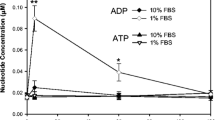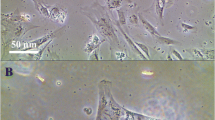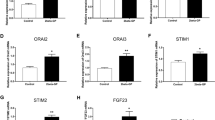Abstract
Heparin has been reported to have many actions similar to calcium-dependent protein kinase (PKC) inhibitors. We have found that puromycin aminonucleoside (PAN) increases hydroxyl radical generation and this was prevented by H-7, a PKC inhibitor in isolated rat hepatocytes. In this study, we investigate the effect of heparin on the increased hydroxyl radical generation as well as PKC activation by PAN in isolated rat hepatocytes. To estimate the amount of hydroxyl radical generation, we measured methylguanidine (MG) and creatol which are the products from the reaction of creatinine and hydroxyl radical. Synthetic rate of MG plus creatol in isolated rat hepatocytes incubated in Krebs-Henseleit bicarbonate buffer containing creatinine and tested reagents were recorded. This rate with or without PAN was 231 ± 11 or 112 ± 5.6 nmol/g wet cells/4 h (mean ± S.E., n = 5), respectively. Heparin concentrations of 3.3, 6.6 and 10 U/ml inhibited MG plus creatol synthesis in the presence of PAN by 30, 38 and 39%, and without PAN by 8.4, 27 and 34%, respectively. Statistical significance was observed except for 3.3 U/ml without PAN. The ratio of PKC in membrane/cytoplasmic fraction, an indicator of PKC activation, increased 2.8- and 3-fold that of the 0 time after 60 and 120 min incubation with PAN while heparin at 10 U/ml almost completely suppressed this increase in the ratio of PKC. The PKC ratio of the membrane/cytoplasmic fraction obtained from hepatocytes with heparin alone or without PAN and heparin was almost unchanged during the tested period. Variation of PKC levels in membrane fraction is similar to that of PKC ratio of the membrane/cytoplasmic fraction. Increased creatol synthesis by PAN and its inhibition by heparin were observed in the same samples as those used for the PKC study.
These results indicate that heparin inhibits the increase in hydroxyl radical generation induced by PAN through inhibition of PKC activation in isolated rat hepatocytes.
Similar content being viewed by others
References
Freedman P, Meister HP, De la Paz A, Ronaghy H: The clinical, functional, and histologic response to heparin in chronic renal disease. Invest Urol 7: 398-409, 1970
Barsotti G, Cupisti A, Gervasi GB, Bartoli C, Barsotti M, Pasquariello A, Moriconi L, Giovannetti S: Effects of oral administration of heparan sulphate in the rat remnant kidney model. Nephron 81: 10-316, 1999
Yokoyama H, Myrup B, Oturai P, Deckert T: Heparin, a possible therapy for diabetic complications: The effect on mesangial and myomedial cells in vivo and in vitro, especially in relation to extracellular matrix. J Diabetes Comp 9: 97-103, 1995
Myrup B, Hansen PM, Jensen T, Kofoed-Enevoldsen A, Feldt-Rasmussen B, Gram J, Kluft C, Jespersen J, Deckert T: Effect of low-dose heparin on urinary albumin excretion in insulin-dependent diabetes mellitus. Lancet 345: 421-422, 1995
Diamond JR, Karnovsky MJ: Nonanticoagulant protective effect of heparin in chronic aminonucleoside nephrosis. Renal Physiol 9: 366-374, 1986
Frenk S, Antonowicz I, Chaig JM, Metecoff J: Experimental nephrotic syndrome induced in rats by aminonucleoside renal lesion and body electrolyte composition. Proc Soc Exp Biol Med 89: 424-427, 1955
Glasser RJ, Velosa JA, Michael AF: Experimental model of focal sclerosis. 1. Relationship to protein excretion in aminonucleoside nephrosis. Lab Invest 36: 527-534, 1977
Castellot JJ Jr, Pukac LA, Caleb BL, Wright TC Jr, Karnovsky MJ: Heparin selectively inhibits a protein kinase C-dependent mechanism of cell cycle progression in calf aortic smooth muscle cells. J Cell Biol 109: 3147-3155, 1989
Xuereb JM, Herbert JM, Sie P, Boneu B, Constans J: Effects of heparin and related sulfated polysaccharides on tissue factor expression induced by mitogenic and non-mitogenic factors in human vascular smooth muscle cells. Thromb Haemost 81: 151-156, 1999
Pukac LA, Castellot JJ Jr, Wright TC Jr, Caleb BL, Karnovsky MJ: Heparin inhibits c-fos and c-myc mRNA expression in vascular smooth muscle cells. Cell Reg 1: 435-443, 1990
Au YP, Kenagy RD, Clowes AW: Heparin selectively inhibits the transcription of tissue-type plasminogen activator in primate arterial smooth muscle cells during mitogenesis. J Biol Chem 267: 3438-3444, 1992
Kenagy RD, Nikkari ST, Welgus HG, Clowes AW: Heparin inhibits the induction of three matrix metalloproteinases (stromelysin, 92-kD gelatinase, and collagenase) in primate arterial smooth muscle cells. J Clin Invest 93: 1987-1993, 1994
Adachi T, Nakashima S, Saji S, Nakamura T, Nozawa Y: Mitogen-activated protein kinase activation in hepatocyte growth factor-stimulated rat hepatocytes: Involvement of protein tyrosine kinase and protein kinase C. Hepatology 23: 1244-1253, 1996
Imai T, Hirata Y, Emori T, Marumo F: Heparin has an inhibitory effect on endothelin-1 synthesis and release by endothelial cells. Hypertension 21: 353-358, 1993
Diamond JR, Bonventre JV, Karnovsk MJ: A role for oxygen free radicals in aminonucleoside nephrosis. Kidney Int 29: 478-483, 1986
Srivastava RN, Diviven S, Kalia A, Travis LB, Ansari NH: Increased glomerular and urinary malondialdehyde in puromycin aminonucleoside-induced proteinuria in rats. Pediatr Nephrol 9: 48-51, 1995
Aoyagi K, Nagase S, Narita M, Tojo S: Role of active oxygen on methylguanidine synthesis in isolated rat hepatocytes. Kidney Int 22: S229-S233, 1987
Aoyagi K, Nagase S, Sakamoto M, Narita M, Tojo S: Puromycin aminonucleoside stimulates the synthesis of methylguanidine: A possible marker of active oxygen generation in isolated rat hepatocytes. In: A. Mori, B.D. Cohen, H. Koide (eds). Guanidines 2. Plenum Press, New York, 1989, pp 71-77
Aoyagi K, Akiyama K, Kuzure Y, Takemura K, Nagase S, Ienaga K, Nakamura K, Koyama A, Narita M: Synthesis of creatol, a hydroxyl radical adduct of creatinine and its increase by puromycin aminonucleoside in isolated rat hepatocytes. Free Radic Res 29: 221-226, 1998
Aoyagi K, Akiyama K, Tomida C, Gotoh M, Hirayama A, Takemura K, Ueda A, Nagase S, Koyama A, Narita M: Imaging of hydroperoxides in a rat glomerulus stimulated by puromycin aminonucleoside. Kidney Int 71(suppl): S153-S155, 1999
Aoyagi K, Takemura K, Tomida C, Goto M, Koyama A, Narita M: Inhibition of methylguanidine synthesis in isolated rat hepatocytes by protein kinase C inhibitor and calmodulin antagonist. In: P.P. De Deyn, B. Maeacau, A. Qureshi, A. Mori (eds). Guanidino Compounds in Biology and Medicine 2. John Libbey & Co. Ltd., London, 1997, pp 311-316
Nakamura K, Lenaga K, Yokozawa T, Fujitsuka N, Oura H: Production of methylguanidine from creatinine via creatol by active oxygen species: Analyses of the catabolism in vitro. Nephron 58: 42-44, 1991
Ienaga K, Nakamura K, Yamakawa H, Yokozawa T, Oura H, Nakano K: The use of 13C-labeling to prove that creatinine is oxidized by mammals into creatol and 5-hydroxy-1-methylhydantonin. J Chem Soc Chem Commun: 509-510, 1991
Aoyagi K, Nagase S, Koyama A, Narita M, Tojo S: Products of creatinine with hydroxyl radical as a useful marker of oxidative stress in vivo. Meth Mol Biol 108: 157-164, 1998
Sakamoto M, Aoyagi K, Nagase S, Ishikawa T, Takemura K, Narita M: Methylguanidine synthesis by reactive oxygen species from human leukocytes. Japanese J Nephrol 31: 851-858, 1998 (in Japanese)
Takemura K, Aoyagi K, Nagase S, Sakamoto M, Ishikawa T, Narita M: Effect of hyperbaric therapy on urinary methylguanidine excretion in normal human and patients with renal failure. In: P.P. De Deyn, B. Marescau, V. Stalon, I.A. Qureshi (eds). Guanidino Compounds in Biology and Medicine. John Libbey & Co. Ltd., London, 1992, pp 301-330
Berry MN, Friend DS: High-yield preparation of isolated liver cells. J Cell Biol 43: 506-520, 1969
Zahlten RN, Stratman FW, Lardy HA: Regulation of glucose synthesis in hormone-sensitive isolated rat hepatocytes. Proc Natl Acad Sci USA 70: 3213-3218, 1973
Aoyagi K, Ohba S, Narita M, Tojo S: Regulation of biosynthesis of guanidinosuccinic acid in isolated rat hepatocytes and in vivo. Kidney Int 24: S224-S228, 1983
Nakamura K, Ienaga K, Nakano K, Nakai M, Nakamura Y, Hasegawa G, Sawada M, Kondo M, Mori H, Kanatsuna T: Creatol, a creatinine metabolite, as a useful determinant of renal function. Nephron 66: 140-146, 1994
Smith PK, Krohn RI, Hermanson GT, Malia AK, Gartner FH, Provenzano MD, Goeke EK, Olson BJ, Klenk DC: Measurement of protein using bicinchoninic acid. Anal Biochem 150: 76-85, 1985
Nishizuka Y: Intracellular signaling by hydrolysis of phospholipids and activation of protein kinase C. Science 258: 607-614, 1992
Dekker LV, Parker PJ: Protein kinase C — a question of specificity. Trends Biochem Sci 19: 73-77, 1984
Nishizuka Y: Protein kinase C and lipid signaling for sustained cellular responses. FASEB J 9: 484-496, 1995
Hardy JF, Belisle S, Robitaille D, Perrault J, Roy M, Gagnon L: Measurement of heparin concentration in whole blood with the Hepcon/HMS device does not agree with laboratory determination of plasma heparin concentration using a chromogenic substrate for activated factor X. J Thoracic Cardiovasc Surg 112: 154-161, 1996
Lapenna D, Mezzetti A, de Gioia S, Ciofani G, Marzio L, Di Ilio C, Cuccurullo F: Heparin: Does it act as an antioxidant in vivo? Biochem Pharmacol 44: 188-191, 1992
Laghi-Pasini F, Pasqui AL, Ceccatelli L, Di Perr T: Heparin inhibits FMLP and Con-A dependent activation of human polymorphonuclear leucocytes in vitro. Int J Tissue React 5: 145-151, 1983
Tanabe T, Otani H, Mishima K, Ogawa R, Inagaki C: Mechanisms of oxyradical production in substance P stimulated rheumatoid synovial cells. Rheumatol Int 16: 159-167, 1996
Liu W, Pitcher DE, Morris SL, Pugmire JE, Shores JT, Ingram CE, Glew RH, Morris DM, Fry DE: Differential effects of heparin on the early and late phases of hepatic ischemia and reperfusion injury in the pig. Shock 12: 134-138, 1999
Burg M, Ostendorf T, Mooney A, Koch KM, Floege J: Treatment of experimental mesangioproliferative glomerulonephritis with non-anticoagulant heparin: Therapeutic efficacy and safety. Lab Invest 6: 505-516, 1997
Wang ZQ, Liang KH, Pahl MV, Vaziri ND: Effect of heparin on mesangial growth and gene expression of matrix proteins. Nephrol Dialysis Transplant 13: 3052-3057, 1998
Hoffman A, Levy G: Kinetics of drug action in disease states. XXIX. Effect of experimental nephrotic syndrome on the pharmacodynamics of eptabarbital: Implications of severe hypoalbuminemia. J Pharmacol Exp Ther 249: 117-122, 1989
Sidhu JS, Omiecinski CJ: Protein synthesis inhibitors exhibit a nonspecific effect on phenobarbital-inducible cytochrome P450 gene expression in primary rat hepatocytes. J Biol Chem 273: 4769-4775, 1998
Pedraza-Chaverri J, Arevalos AE: Tissue lipoperoxidation and glutathione peroxidase activity in puromycin aminonucleoside injected rats. Int J Biochem 26: 1139-1145, 1994
Roma MG, Orsler DJ, Coleman R: Canalicular retention as an in vitro assay of tight junctional permeability in isolated hepatocyte couplets: Effects of protein kinase modulation and cholestatic agents. Fund Appl Toxicol 37: 71-81, 1997
Bruck R, Nathanson MH, Roelofsen H, Boyer JL: Effects of protein kinase C and cytosolic Ca2+ on exocytosis in the isolated perfused rat liver. Hepatology 20: 1032-1040, 1994
Adachi T, Nakashima S, Saji S, Nakamura T, Nozaw Y: Mitogen-activated protein kinase activation in hepatocyte growth factor-stimulated rat hepatocytes: Involvement of protein tyrosine kinase and protein kinase C. Hepatology 23: 1244-1253, 1996
Adachi T, Nakashima S, Saji S, Nakamura T, Nozawa Y: Phospholipase D activation in hepatocyte growth factor-stimulated rat hepatocytes mediates the expressions of c-jun and c-fos: Involvement of protein tyrosine kinase, protein kinase C, and Ca2+. Hepatology 24: 1274-1281, 1996
Yu P, Chen Q, Xiao Z, Harnett K, Biancani P, Behar J: Signal transduction pathways mediating CCK-induced gall bladder muscle contraction. Am J Physiol 275: G203-G211, 1998
Murthy KS, Grider JR, Makhlouf GM: Receptor-coupled G proteins mediate contraction and Ca2+ mobilization in isolated intestinal muscle cells. J Pharmacol Exp Ther 260: 90-97, 1992
Tanabe T, Otani H, Mishima K, Ogawa R, Inagaki C: Mechanisms of oxyradical production in substance P stimulated rheumatoid synovial cells. Rheumatol Int 16: 159-167, 1996
Author information
Authors and Affiliations
Rights and permissions
About this article
Cite this article
Aoyagi, K., Kuzure, Y., Shahrzad, S. et al. Inhibition by heparin of protein kinase C activation and hydroxyl radical generation in puromycin aminonucleoside treated isolated rat hepatocytes. Mol Cell Biochem 244, 3–9 (2003). https://doi.org/10.1023/A:1022427000249
Issue Date:
DOI: https://doi.org/10.1023/A:1022427000249




